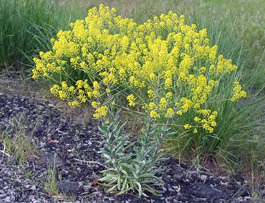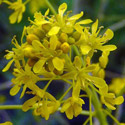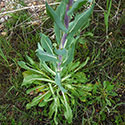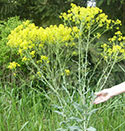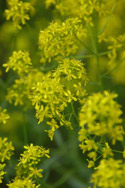Dyers Woad
Isatis tinctoria • Class A |
||
| Family Name: | Brassicaceae family (brass-ih-KAY-see-ee) | |
| Common: | Cabbage family | |
| Genus: |
Isatis (EYE-sat-iss) Meaning: Ancient Greek name for this plant |
|
| Species: |
tinctoria (tink-TOR-ee-uh) Meaning: Indicates a plant used in dyeing or that has a sap that can stain |
|
| Description: |
This biennial or short lived perennial grows from 1 to 4 feet tall with a 3 to 5 foot long taproot. The basal leaves at the stem base are stalked, bluish green, and covered with fine hairs. Stem leaves leaves are lnace shaped, alternate, 1 to 7 inches long, with a whitish mid vein and not stalk. When the rosette bolts, up to 20 stems can be produced. Its small yellow flowers bloom from April to June and are cross shaped with 4 sepals, 4 petals, 6 stamens. Flowers are found in clusters on the branch tips. |
||||
| Why Is it a Noxious Weed? |
Dyer's Woad is a very aggressive weed with the ability to form a monoculture and is non-palatable. Rotting seed pods contain a chemical with allelopathic properties that limits the root development of surrounding plants and allows D.W. to outcompete other plants. |
||||
| Where Does it Grow? |
Dyer's Woad will establish in rocky soils, along road sides, gravel pits, levees and railroad rights-of-ways. From there it has the ability to spread by seed to well vegetated pastures, forests, waterways, hayfields and crop lands. |
||||
| Facts: |
Dyer's woad was used as a source for blue dye (indigo) since the 13th century and it was cultivated till the 1930’s in England. Indigotine, the blue dye chemical, is located in the leaves. |
||||
| Control Options: |
|
||||
| More Information: |
For more information on this noxious weed Download our Flyer or visit Washington State Noxious Weed Control Board Here. Photos by Rebecca Shoemaker, Pierce County Noxious Weed Control Board.
|
||||
| More Pictures: |
|
